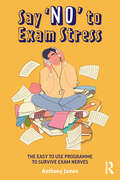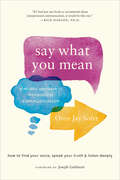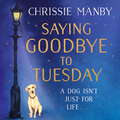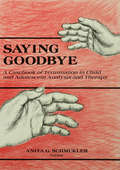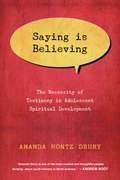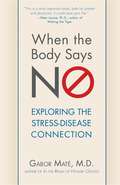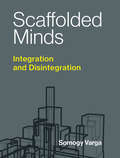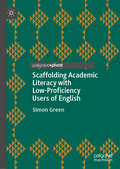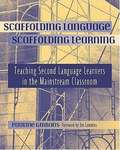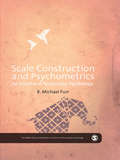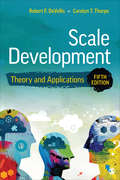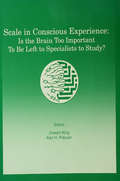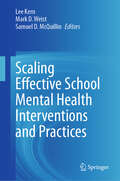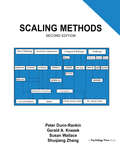- Table View
- List View
Savvy: Dealing with People, Power and Politics at Work
by Jane ClarkeShortlisted for the CMI Management Book of the Year 2012http://yearbook.managers.org.uk/the-commuters-read-shortlistDealing with office politics, conflict and difficult people at work, without compromising your values and integrity, can be tricky. With case studies and examples, Savvy will help you understand colleagues' behaviour and power dynamics at work, and learn how to negotiate them successfully.Practical and insightful, Savvy will enable you to master the necessary skills to deal with difficult situations. It includes step-by-step advice on how tobuild a network, develop the right mindset, handle conflict, manage your boss, influence others and deal with a bully.Savvy is the essential office survival guide that will help you to boost your career and ensure your professional success.
Say 'No' to Exam Stress: The Easy to Use Programme to Survive Exam Nerves
by Anthony JamesExams are important. The results can change lives and stressing about them can damage performance and undermine young peoples' confidence. This exam stress management programme requires very little time or effort to use and provides a straightforward, practical guide to exam stress management. Written by an experienced educational psychologist, this short, explanatory book is accompanied by simple, easy to follow audio files which lead the listener through a sequence of five relaxation sessions to reduce stress, increase focus and plan for success. Using the book as a guide you simply listen to the audio tracks and follow what they say. All tracks have been designed so that they are easy to digest and applicable in the middle of a busy day. To sum up, this book:• Provides practical and easy to follow steps to help anyone cope with exam stress• Teaches relaxation techniques that can be used to reduce stress wherever you find it • Offers a real stress knowledge base to teachers and family members supporting students with exam stressThis important guide is suitable for secondary school students as well as college and university students. The easy to follow relaxation sessions will be of interest to anyone studying for examinations who wishes to lower their exam stress levels.
Say Good Night to Insomnia: The Six-week, Drug-free Program Developed at Harvard Medical School
by Gregg D. JacobsSince publication of the first edition of this book, sleep-deprived Americans have found natural, drug-free relief from insomnia with the help of Dr. Gregg D. Jacobs's definitive guide, Say Good Night to Insomnia. Jacobs's program, developed and tested at Harvard Medical School and based on cognitive behavioral therapy, is the gold standard for treatment. He provides techniques for: (1) ELIMINATING SLEEPING PILLS; (2) ESTABLISHING SLEEP-PROMOTING BEHAVIORS AND LIFESTYLE PRACTICES; (3) IMPROVING RELAXATION, REDUCING STRESS, AND CHANGING NEGATIVE THOUGHTS ABOUT SLEEP. In this updated edition, Jacobs, an insomnia specialist at the Sleep Disorders Center at the University of Massachusetts Medical School, surveys the limitations and dangers of the new generation of sleeping pills, dispels misleading and confusing claims about sleep and health, and shares cutting-edge research on insomnia that proves his approach is more effective than pills.
Say This, Not That
by Carl AlaskoDo you words often crate the opposite effect of what you were hoping for―escalating tensions rather than solving problems? The author of Emotional Bullshit, Carl Alasko, believes that anyone can learn effective communication skills. In Say This, Not That, he provides simple instructions for what to say―and what not to say―in the moments when it really counts 9and not after the fact, when it doesn't). Accompanying each set of statements is a brief discussion about what makes one statement negative and destructive, and the other positive and effective. Guiding you in cultivating the ability to say what you really want to say in all areas of life―from dating and relationships to parenting and the workplace―Say This, Not That, is the ultimate resource for anyone who longs to consistently say the right thing at the right time. 'There's been a lot of conversation about holding better conversations, but in Say This, Not That, Carl Alasko takes you to a new level of practicality. With content your can apply immediately, you'll discover ways to enhance all of your relationships. ' John G. Miller, author of QBQ! The Question Behind the Question, Outstanding! and Parenting the QBQ Way'This straightforward, easy-to-use guide will help you find the right words to say in the trickiest of situations. ' Laurie Puhn, J. D. , author of Fight Less, Love More
Say What You Mean: A Mindful Approach to Nonviolent Communication
by Oren Jay SoferFind your voice, speak your truth, listen deeply—a guide to more meaningful and mindful conversations.We spend so much of our lives talking to each other, but how much are we simply running on automatic—relying on old habits and hoping for the best? Are we able to truly hear others and speak our mind in a clear and kind way, without needing to get defensive or go on the attack? In this groundbreaking synthesis of mindfulness, somatics, and Nonviolent Communication, Oren Jay Sofer offers simple yet powerful practices to develop healthy, effective, and satisfying ways of communicating. The techniques in Say What You Mean will help you to: · Feel confident during conversation · Stay focused on what really matters in an interaction · Listen for the authentic concerns behind what others say · Reduce anxiety before and during difficult conversations · Find nourishment in day-to-day interactions
Say the Right Thing: How to Talk About Identity, Diversity, and Justice
by Kenji Yoshino David GlasgowA Living Now Book Awards Gold Medalist, Social Activism/Charity A practical, shame-free guide for navigating conversations across our differences at a time of rapid social change.In the current period of social and political unrest, conversations about identity are becoming more frequent and more difficult. On subjects like critical race theory, gender equity in the workplace, and LGBTQ-inclusive classrooms, many of us are understandably fearful of saying the wrong thing. That fear can sometimes prevent us from speaking up at all, depriving people from marginalized groups of support and stalling progress toward a more just and inclusive society. Kenji Yoshino and David Glasgow, founders of the Meltzer Center for Diversity, Inclusion, and Belonging at NYU School of Law, are here to show potential allies that these conversations don&’t have to be so overwhelming. Through stories drawn from contexts as varied as social media posts, dinner party conversations, and workplace disputes, they offer seven user-friendly principles that teach skills such as how to avoid common conversational pitfalls, engage in respectful disagreement, offer authentic apologies, and better support people in our lives who experience bias. Research-backed, accessible, and uplifting, Say the Right Thing charts a pathway out of cancel culture toward more meaningful and empathetic dialogue on issues of identity. It also gives us the practical tools to do good in our spheres of influence. Whether managing diverse teams at work, navigating issues of inclusion at college, or challenging biased comments at a family barbecue, Yoshino and Glasgow help us move from unconsciously hurting people to consciously helping them.
Say the Thing: Boundary-Setting Scripts & Phrases to Communicate Directly & Speak Up with Kindness
by Kami OrangePacked with boundary-setting phrases and sample dialogue scripts, this book offers easy-to-remember guidance for navigating life's trickier conversations, and encourages readers to communicate kindly and directly on a variety of sensitive topics.If you are looking to learn how to express what you truly feel and ask for what you want in a kind and direct way, this book will help you take control of situations and set boundaries that work for you in your environment. Giving hundreds of examples of boundary phrases and conversation scripts, it&’s designed to be both easy to read and an accessible reference to pull out again and again when you need boundary-setting guidance. Featuring three boundary phrase frameworks and a multitude of topics for use in each, this book suggests communication strategies for speaking compassionately about:body image sexual orientationracerelationshipsand much more!With her friendly voice and a spark of humor, boundary coach Kami Orange is here to help you navigate life's tricky situations and learn how to stand up for yourself, for others, and to say the thing.
Saying Goodbye
by Joseph Nowinski Barbara OkunWhen someone you love receives a terminal diagnosis, the whole family is suddenly faced with a prolonged crisis. While medical advances have given us the gift of extending life, meaning that a loved one could survive months or even years before dying, it has also changed the way we grieve. Published in collaboration with Harvard Health Publications, Saying Goodbye guides you through this complex journey, offering hope and healing for those who may be "living with death" for an extended period of time.
Saying Goodbye to Tuesday: A heart-warming and uplifting novel for anyone who has ever loved a dog
by Chrissie ManbyStupendo the dog has died. But that's just the beginning of his story.To love and protect. The code of the good dog is clear. When single mother Tuesday took on mongrel pup Stupendo, she made a friend for life. Through the best and the worst of times, Stupendo has been there for her. Ever faithful, ever loyal, ever true. Nothing could break their bond. Until last week. Stupendo doesn't know why Tuesday is suddenly ignoring him or why his doggy antics no longer seem to soothe Baby William. It takes his worst enemy - the cat next door - to break the news that Stupendo has become a ghost. Somehow left behind on Earth, Stupendo knows he has unfinished business. Enlisting the help of the community of animals in the neighbourhood, Stupendo must get to the bottom of the very human sadness that hangs over his old home and keeps him from saying goodbye to Tuesday.(P) 2021 Hodder & Stoughton Limited
Saying Goodbye: A Casebook of Termination in Child and Adolescent Analysis and Therapy
by Anita G. SchmuklerTermination of psychoanalysis or psychotherapy is centrally important both to the process of treatment and to the patient's experience of treatment. It is surprising, then, that there has heretofore been no comprehensive study of the subject. This book begins to bridge the gap in this area. It is the first volume devoted entirely to issues surrounding the ending of treatment in analytic and therapeutic work with children and adolescents. Organized into separate clinical and theoretical sections, framed by a preface and sectional introductions, and covering a wide range of psychopathology, this book explores the different ways in which children and adolescents grapple with the experience of separation at the conclusion of treatment. Of special note is the contributors' recognition that the parents of children ending treatment face their own termination experience in relinquishing the support of their child's therapist. The presentations are enriched, as well, by frank discussions of countertransference as it enters into the termination phase of treatment.
Saying Goodbye: A personal story of baby loss and 90 days of support to walk you through grief
by Zoe Clark-CoatesLosing a baby, whether through miscarriage, stillbirth or neonatal death, leaves so many parents lost in grief and full of unanswered questions. Zoë Clark-Coates, and her husband Andy, have personally faced the loss of five babies. Out of their experiences came the charity The Mariposa Trust (more often known by its leading division Saying Goodbye), offering support to thousands of grieving parents and relatives around the world each week. Now, Zoë writes a moving account of their experiences and how they found a way through to provide help and support for others. Alongside this are 90 days of daily support for those who are grieving, offering comfort and hope during the difficult days, weeks and months.
Saying Is Believing: The Necessity of Testimony in Adolescent Spiritual Development
by Amanda Hontz Drury"I have seen and I testify . . ." (John 1:34) The idea of giving one's testimony often evokes summer church camps, evangelistic revivals, mission trips and baptisms. Like an eyewitness called to testify in a courtroom, sharing a testimony of faith is for specific people at special moments. But what if our view of testimony is all wrong? According to Amanda Drury, testimony is not merely about describing something that happened in the past. It is a practice that forms our present and future identity. Testimony changes us, and without it we risk having a stunted and stale faith. Drawing on work in sociology, psychology and theology, Drury develops an understanding of testimony as an essential practice for Christian spiritual formation, especially for adolescents who are in the process of developing their identity. Recent studies reveal a staggering inability for adolescents to articulate their religious beliefs. Now more than ever, churches need to recover the practice of testimony as an integral part of communal worship.
Saying, Seeing and Acting: The Psychological Semantics of Spatial Prepositions (Essays in Cognitive Psychology)
by Kenny R. Coventry Simon C. GarrodOur use of spatial prepositions carries an implicit understanding of the functional relationships both between objects themselves and human interaction with those objects.This is the thesis rigorously explicated in Saying, Seeing and Acting. It aims to account not only for our theoretical comprehension of spatial relations but our ability to intercede with efficacy in the world of spatially related objects. Only the phenomenon of functionality can adequately account for what even the simplest of everyday experiences show to be the technically problematic, but still meaningful status of expressions of spatial location in contentious cases.The terms of the debate are established and contextualised in Part One. In the Second Section, systematic experimental evidence is drawn upon to demonstrate specific covariances between spatial world and spatial language. The authors go on to give an original account of the functional and geometric constraints on which comprehension and human action among spatially related objects is based. Part Three looks at the interaction of these constraints to create a truly dynamic functional geometric framework for the meaningful use of spatial prepositions.Fascinating to anyone whose work touches on psycholinguistics, this book represents a thorough and incisive contribution to debates in the cognitive psychology of language.
Says No: Exploring the Stress-Disease Connection
by Gabor MateExplores the role of the mind-body link in conditions and diseases such as arthritis, cancer, diabetes, heart disease, IBS, and multiple sclerosis, Draws on medical research and the author's clinical experience as a family physician, Includes The Seven A's of Healing-principles of healing and the prevention of illness from hidden stress.
Scaffolded Minds: Integration and Disintegration (Philosophical Psychopathology)
by Somogy VargaA comprehensive account of cognitive scaffolding and its significance for understanding mental disorders.In Scaffolded Minds, Somogy Varga offers a novel account of cognitive scaffolding and its significance for understanding mental disorders. The book is part of the growing philosophical engagement with empirically informed philosophy of mind, which studies the interfaces between philosophy and cognitive science. Varga draws on two recent shifts within empirically informed philosophy of mind: the first, toward an intensified study of the embodied mind; and the second, toward a study of the disordered mind that acknowledges the convergence of the explanatory concerns of psychiatry and interdisciplinary inquiries into the mind.Varga sets out to accomplish a dual task: theoretical mapping of cognitive scaffolding; and the application/calibration of fine-grained philosophical distinctions to empirical research. He introduces the notion of actively scaffolded cognition (ASC) and offers a taxonomy that distinguishes between intrasomatic and extrasomatic scaffolding. He then shows that ASC offers a productive framework for considering certain characteristic features of mental disorders, focusing on altered bodily experience and social cognition deficits. With Cognitive Scaffolding, Varga aims to establish that shifting attention from mental symptoms to fine-grained sensorimotor aspects can lead to identifying diagnostic subtypes or even specific sensorimotor markers for early diagnosis.
Scaffolding Academic Literacy with Low-Proficiency Users of English
by Simon GreenThis book analyses the development of academic literacy in low-proficiency users of English in the Middle East. It highlights the challenges faced by students entering undergraduate education in the region, and the strategies used by teachers to overcome them. The author focuses on a large-scale undergraduate teacher programme run in Oman by the University of Leeds, providing clear pointers both for future research and effective practice. He also explores the implications of his findings for countries beyond the Gulf Cooperation Council, demonstrating how international participation in UK HE could be much wider. This book will appeal to students and scholars with an interest in academic literacies and English for Academic Purposes.
Scaffolding Language
by Pauline GibbonsThe bestselling Scaffolding Language, Scaffolding Learning helped tens of thousands of mainstream elementary teachers ensure that their English language learners became full members of the school community with the language and content skills they needed for success. In the highly anticipated Second Edition, Pauline Gibbons updates her classic text with a multitude of practical ideas for the classroom, supported by the latest research in the field of ELL/ESL. With clear directions and classroom tested strategies for supporting students' academic progress, Gibbons shows how the teaching of language can be integrated seamlessly with the teaching of content, and how academic achievement can be boosted without sacrificing our own vision of education to the dictates of knee-jerk accountability. Rich examples of classroom discourse illustrate exactly how the scaffolding process works, while activities to facilitate conversation and higher-level thinking put the latest research on second language learning into action.
Scaffolding Language, Scaffolding Learning: Teaching Second Language Learners in the Mainstream Classroom
by Jim Cummins Pauline GibbonsHow does a mainstream elementary classroom teacher with little or no specialized ESL training meet the challenge of teaching linguistically diverse students? Pauline Gibbons suggests how: integrate the teaching of English with the content areas of the regular curriculum. What's more, she shows how in this practical resource book. Gibbons begins with a strong theoretical underpinning for her practice, drawing on a functional model of language, sociocultural theories of learning, and current research on second-language development. After supporting her view that the regular curriculum offers the best language-learning environment for young ESL students, Gibbons demonstrates the ways in which content areas provide a context for the teaching of English, from speaking and listening to reading and writing. These in turn are treated not as discrete skills, but as ones that can also be integrated in the learning of diverse subjects. Gibbons illustrates this with a wide range of teaching and learning activities across the curriculum, supplemented with programming and assessment formats and checklists. Language learning is not a simple linear process, but involves the ongoing development of skills for a range of purposes. Gibbons sees this development as largely the result of the social contexts and interactions in which learning occurs. By focusing on the ways in which teachers can "scaffold" language and learning in the content areas, she takes a holistic approach-one that appreciates the struggle of students learning a new language, while simultaneously developing subject knowledge in it, and the challenge for teachers to address these needs. Given today's culturally and linguistically diverse classrooms, ESL students can no longer be thought of as a group apart from the mainstream-they are. the mainstream. This book describes the ways to ensure that ESL learners become full members of the school community with the language and content skills they need for success.
Scaffolding: A Special Issue of the Journal of the Learning Sciences
by Elizabeth A. Davis Naomi Miyake GuestThis special issue works toward refining the understanding of a construct that has had a name for nearly 30 years and has been used by educators of all stripes for centuries. The introduction lays the groundwork for discussing the issues addressed throughout. Each of the papers address different aspects of a similar problem: How can we conceptualize, design, and assess the effects of scaffolding when it is implemented in a complex classroom system? The first article addresses a core problem in conceptualizing scaffolding: What are the specific goals of scaffolding provided in software tools? The next paper extends this consideration of how scaffolding mechanisms can complement each other and explores issues having to do with the complex settings in which scaffolding is used. A framework which synthesizes theoretical and design work done in cognitive science, psychology, educational technology, science education, and the learning sciences over the last three decades is the topic of the third paper. The final article presents a new method for analyzing the effects of scaffolding. This special issues closes with commentary covering different components of a definition of scaffolding, including the "what, why, and how" of scaffolding.
Scale Construction and Psychometrics for Social and Personality Psychology: For Social And Personality Psychology (The SAGE Library of Methods in Social and Personality Psychology)
by R. Michael FurrProviding conceptual and practical foundations in scale construction and psychometrics for producers and consumers of social/personality research, this guide covers basic principles, practices, and processes in scale construction, scale evaluation, scale use, and interpretation of research results in the context of psychological measurement. It explains fundamental concepts and methods related to dimensionality, reliability, and validity. In addition, it provides relatively non-technical introductions to special topics and advanced psychometric perspectives such as Confirmatory Factor Analysis, Generalizability Theory, and Item Response Theory. The SAGE Library in Social and Personality Psychology Methods provides students and researchers with an understanding of the methods and techniques essential to conducting cutting-edge research. Each volume within the Library explains a specific topic and has been written by an active scholar (or scholars) with expertise in that particular methodological domain. Assuming no prior knowledge of the topic, the volumes are clear and accessible for all readers. In each volume, a topic is introduced, applications are discussed, and readers are led step by step through worked examples. In addition, advice about how to interpret and prepare results for publication are presented.
Scale Development: Theory and Applications (Applied Social Research Methods)
by Robert F. DeVellis Carolyn T. ThorpeScale Development: Theory and Applications, by Robert F. DeVellis and new co-author Carolyn T. Thorpe, demystifies measurement by emphasizing a logical rather than strictly mathematical understanding of concepts. The Fifth Edition includes a new chapter that lays out the key concepts that distinguish indices from scales, contrasts various types of indices, suggests approaches for developing them, reviews validity and reliability issues, and discusses in broad terms some analytic approaches. All chapters have been updated, and the book strikes a balance between including relevant topics and highlighting recent developments in measurement while retaining an accessible, user-friendly approach to the material covered.
Scale Development: Theory and Applications (Applied Social Research Methods)
by Robert F. DeVellis Carolyn T. ThorpeScale Development: Theory and Applications, by Robert F. DeVellis and new co-author Carolyn T. Thorpe, demystifies measurement by emphasizing a logical rather than strictly mathematical understanding of concepts. The Fifth Edition includes a new chapter that lays out the key concepts that distinguish indices from scales, contrasts various types of indices, suggests approaches for developing them, reviews validity and reliability issues, and discusses in broad terms some analytic approaches. All chapters have been updated, and the book strikes a balance between including relevant topics and highlighting recent developments in measurement while retaining an accessible, user-friendly approach to the material covered.
Scale in Conscious Experience: Is the Brain Too Important To Be Left To Specialists To Study? (INNS Series of Texts, Monographs, and Proceedings Series)
by Karl H. Pribram Joseph KingThis volume is the result of the third Appalachian Conference on Behavioral Neurodynamics which focused on the problem of scale in conscious experience. Set against the philosophical view of "eliminative materialism," the purpose of this conference was to facilitate communication among investigators who approach the study of consciousness and conscious phenomena from a variety of analytical levels. One speculative outcome of the conference is that the columnar arrangement within primary sensory cortices may provide the local isolation necessary for nonlocal interactions to occur. In addition, the relationship between unit activity and field potentials within a circumscribed region of cortex may provide the other enigmatic aspect of neurophysiological nonlocality, namely, the common context in the macro scale. So instead of a problem looking for a solution, scale becomes a solution to a problem. Only further research will determine the utility of the ideas expressed here.
Scaling Effective School Mental Health Interventions and Practices
by Mark D. Weist Lee Kern Samuel D. McQuillinThis book describes key practices to bring school mental health programs to scale in a sustainable and effective manner. It emphasizes practices that facilitate the organization and delivery of evidence-based mental health interventions in schools. The volume addresses systems issues and practices that lay the groundwork for creating sustainable school mental health programs. It explores important considerations at the school, district, and state levels; tiered intervention as a framework to support school mental health; preparing the workforce; resource utilization and assuring cultural responsiveness and equity for under-served groups of students. In addition, the book focuses on recent and emerging evidence-based practices for practicably scaling school mental health in schools. Chapters examine systematic screening, followed by specific interventions, including just-in-time training and single session interventions. The book concludes with a focus on ways to address systemic barriers to school mental health, such as addressing the mental health of immigrants. Key areas of coverage include: Communities of practice at different levels of scale (e.g., school building, national). Resource mapping across schools and communities. Screening to match student needs with interventions. Systemic issues in service delivery. Scaling Effective School Mental Health Interventions and Practices is a must-have resource for practitioners, clinicians, and mental health therapists as well as researchers, professors, and graduate students across such interrelated disciplines as school, clinical, and counseling psychology, educational policy and government relations, social work, public health; family leaders and advocates, and medicine and allied health professions (e.g., psychiatry, primary care, nursing, speech and occupational therapy)
Scaling Methods
by Peter Dunn-Rankin Gerald A. Knezek Susan R. Wallace Shuqiang ZhangScaling Methods is written for professionals in the behavioral sciences who analyze data that results from subjective responses. Other books on scaling attitudes or measuring perceptions focus on the psychometrician's view of measurement. This book focuses on the users' view by concentrating on effective ways to analyze data rather than the mathematical details of how each program works. The methods included handle the majority of data analysis problems encountered and are accompanied by a software solution. Each chapter features the theory surrounding that methodology, an example, a real-world application, and a computer solution.This book introduces the major uni- and multi-dimensional scaling method techniques most common in educational, social, and psychological research. Using four primary methods of data collection--ordering, categorical rating, free clustering, and similarity judgments--Scaling Methods, Second Edition explains how such data can be represented in ways that illustrate relationships among the data and help reveal underlying dimensional structures. Each method serves as an independent unit so readers can pick and choose from a variety of easy-to-use procedures and more advanced techniques. The new edition features a new chapter on order analysis and downloadable resources that provide stand-alone, as well as SAS supported demonstrations of multi-dimensional scaling techniques, plus programs to get raw data into matrix form. The text is written for researchers, practitioners, and advanced students in education and the social and behavioral sciences interested in analyzing data resulting from subjective responses, especially in the measurement of attitudes. Each chapter is self-contained making this an excellent resource for use in the classroom or as a self-study tool. A first course in statistics is a helpful prerequisite.

